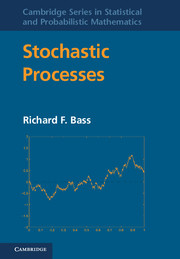Book contents
- Frontmatter
- Contents
- Preface
- Frequently used notation
- 1 Basic notions
- 2 Brownian motion
- 3 Martingales
- 4 Markov properties of Brownian motion
- 5 The Poisson process
- 6 Construction of Brownian motion
- 7 Path properties of Brownian motion
- 8 The continuity of paths
- 9 Continuous semimartingales
- 10 Stochastic integrals
- 11 Itô's formula
- 12 Some applications of Itô's formula
- 13 The Girsanov theorem
- 14 Local times
- 15 Skorokhod embedding
- 16 The general theory of processes
- 17 Processes with jumps
- 18 Poisson point processes
- 19 Framework for Markov processes
- 20 Markov properties
- 21 Applications of the Markov properties
- 22 Transformations of Markov processes
- 23 Optimal stopping
- 24 Stochastic differential equations
- 25 Weak solutions of SDEs
- 26 The Ray–Knight theorems
- 27 Brownian excursions
- 28 Financial mathematics
- 29 Filtering
- 30 Convergence of probability measures
- 31 Skorokhod representation
- 32 The space C[0, 1]
- 33 Gaussian processes
- 34 The space D[0, 1]
- 35 Applications of weak convergence
- 36 Semigroups
- 37 Infinitesimal generators
- 38 Dirichlet forms
- 39 Markov processes and SDEs
- 40 Solving partial differential equations
- 41 One-dimensional diffusions
- 42 Lévy processes
- Appendices
- A Basic probability
- B Some results from analysis
- C Regular conditional probabilities
- D Kolmogorov extension theorem
- References
- Index
B - Some results from analysis
from Appendices
Published online by Cambridge University Press: 05 June 2012
- Frontmatter
- Contents
- Preface
- Frequently used notation
- 1 Basic notions
- 2 Brownian motion
- 3 Martingales
- 4 Markov properties of Brownian motion
- 5 The Poisson process
- 6 Construction of Brownian motion
- 7 Path properties of Brownian motion
- 8 The continuity of paths
- 9 Continuous semimartingales
- 10 Stochastic integrals
- 11 Itô's formula
- 12 Some applications of Itô's formula
- 13 The Girsanov theorem
- 14 Local times
- 15 Skorokhod embedding
- 16 The general theory of processes
- 17 Processes with jumps
- 18 Poisson point processes
- 19 Framework for Markov processes
- 20 Markov properties
- 21 Applications of the Markov properties
- 22 Transformations of Markov processes
- 23 Optimal stopping
- 24 Stochastic differential equations
- 25 Weak solutions of SDEs
- 26 The Ray–Knight theorems
- 27 Brownian excursions
- 28 Financial mathematics
- 29 Filtering
- 30 Convergence of probability measures
- 31 Skorokhod representation
- 32 The space C[0, 1]
- 33 Gaussian processes
- 34 The space D[0, 1]
- 35 Applications of weak convergence
- 36 Semigroups
- 37 Infinitesimal generators
- 38 Dirichlet forms
- 39 Markov processes and SDEs
- 40 Solving partial differential equations
- 41 One-dimensional diffusions
- 42 Lévy processes
- Appendices
- A Basic probability
- B Some results from analysis
- C Regular conditional probabilities
- D Kolmogorov extension theorem
- References
- Index
Summary
The monotone class theorem
The monotone class theorem is a result from measure theory used in the proof of the Fubini theorem.
Definition B.1 ℳ is a monotone class if ℳ is a collection of subsets of X such that
(1) if A1 ⊂ A2 ⊂ …, A = ∪iAi, and each Ai ∈ ℳ, then A ∊ ℳ;
(2) if A1 ⊃ A2 ⊃ …, A = ∊ ℳ∩Ai, and each Ai ∈ ℳ, then A ∈ ℳ.
Recall that an algebra of sets is a collection A of sets such that if A1,…, An ∈ A, then A1 ∪ · ∪ An and A1 ∩ · ∩ An are also in A, and if A ∈ A, then Ac ∈ A.
The intersection ofmonotone classes is a monotone class, and the intersection of all monotone classes containing a given collection of sets is the smallest monotone class containing that collection.
Theorem B.2Suppose A0is an algebra of sets, A is the smallest σ-field containing A0, and ℳ is the smallest monotone class containing A0. Then ℳ = A.
Proof A σ-algebra is clearly a monotone class, so ℳ ⊂ A. We must show A ⊂ ℳ.
Let N1 ={A ∈ ℳ : Ac ℳ}. Note N1 is contained in ℳ, contains A0, and is a monotone class. Since ℳ is the smallest monotone class containing A0, then N = A, and therefore ℳ is closed under the operation of taking complements.
- Type
- Chapter
- Information
- Stochastic Processes , pp. 378 - 379Publisher: Cambridge University PressPrint publication year: 2011



